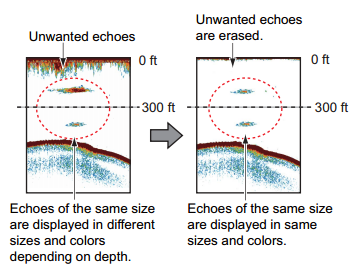Sounder Controls
The "Furuno Sounder Module" needs to be unlocked to access the sounder/fish finder features.
TX/STBY activation and controls for mode, gain and clutter can be set from the Sounder Layers button, or directly from the NavData "Sounder Control". If not available, add it to the NavData panel for quick access to these controls:
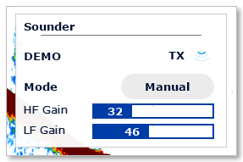
Automatic Mode:
There are two types of automatic fish finder modes: "Auto Fishing" and "Auto Cruising". These settings can be adjusted from the "Layer" button. "Auto Fishing" optimizes the sounder to display schools of fish, and "Auto Cruising" optimize the sounder to detect the bottom. "Auto Cruising" uses a higher clutter removal setting than "Auto Fishing". Do not use "Auto Cruising" when your purpose is to find fish, because the clutter removal circuit can erase weak echoes. The automatic fish finder function automatically adjusts the gain, clutter, TVG and echo offset:
-
The sensitivity of the receiver (Gain) is adjusted to show the bottom echo in reddish-brown
-
The Clutter Adjustment is set to automatically reduce low-level noise like plankton.
-
The TVG function is automatically adjusted.
-
The echo offset balances the gain on high and low frequencies.
There is an independent "Auto-Range" control (available from \the "Layer" button) that adjusts the range of the sounder automatically to track the bottom. Note that, if the sounder loses bottom, the range will automatically cycle through all the values until a good bottom (depth) is found again. In certain cases, (when the bottom disappear due to the boat moving at high speed), it is recommended to de-activate "Auto Range" to prevent the sounder from cycling through the various ranges.
Manual Mode:
When you select "Manual", you can manually adjust the Low and High frequency Gain of the sounder.
Gain: The gain controls how echoes of different strengths are displayed on the screen. Set the gain to show a slight amount of noise on the screen. Increase the gain for greater depths and lower the gain for shallow waters:
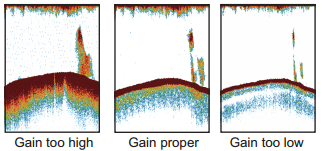
Range: When "Auto Range" is turned OFF from the "Layer" button, you can manually adjust the range by clicking on the "Range +" or "Range -" buttons located on the Toolbar. You can enable or disable specific ranges value from the Sounder by clicking on "Sounder Ranges Selection". This allows you to only cycle through and limit the depth ranges that are useful for your application. You can also use the wheel of your mouse to change the range to any value (not restricted by the Sounder Range Selection).
Range Shift: You can "offset" or shift the range from the Sounder Options by entering a value in the "Range Shift" setting or by dragging the sounder picture downward.
Clutter: If low intensity “spots” of noise appear over most of the screen like in the illustration shown below (caused by sediment in the water or noise) you can increase the "Clutter" slider available in the Sounder Options.

Picture Advanced: The "picture advance" setting available in the Sounder Options controls how quickly the vertical scan lines (pings) of the sounder move across the screen. A fast advance speed expands the size of a school of fish horizontally on the screen. A slow advance speed shortens the school of fish. Use a fast advance speed to see the hard bottom. Use a slow advance speed to see the smooth bottom.
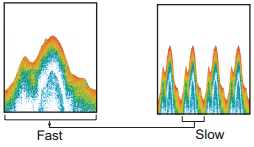
For most application, it is recommended to leave the picture advance to "1".
Interference Rejection: This setting available from the Sounder Options. Only use the Interference Rejection when noise appears on the screen due to other sounder around you or if you have interference from electrical equipment:
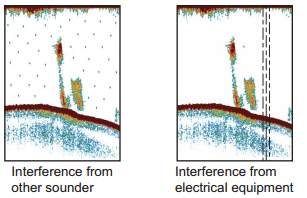
TVG: The TVG settings (HF and LF) available in the Sounder Options can be used to balance the echo strength along the water column. A school of fish at a depth deeper than a school of equal strength in shallow water appears in weaker colors. This condition is caused by the attenuation of the ultrasonic wave. To display the schools of fish in the same colors, use the TVG. The TVG automatically increases the gain with depth so that echoes of the same strength and different depths are shown in the same colors. In the illustration shown below, for example, the TVG is set for 300 ft and the TVG level is adjusted. Unnecessary echoes at a distance less than 300 ft are deleted and echoes at depths greater than 300 ft are not adjusted
